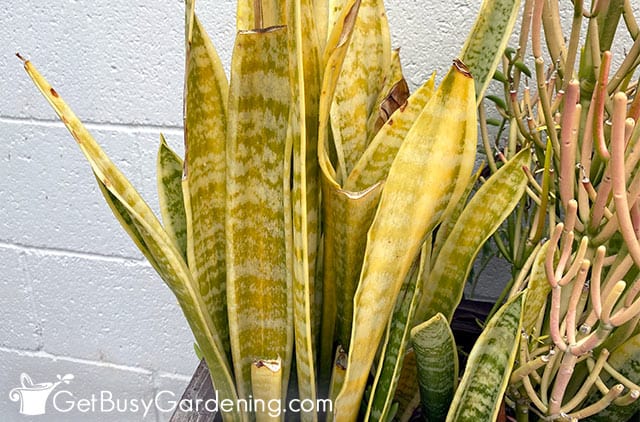Snake Plant Leaves Turning Yellow Can Be Fun For Anyone
Little Known Facts About Snake Plant Leaves Turning Yellow.
Table of ContentsGet This Report about Snake Plant Leaves Turning YellowSome Known Factual Statements About Snake Plant Leaves Turning Yellow Snake Plant Leaves Turning Yellow Fundamentals ExplainedThe Facts About Snake Plant Leaves Turning Yellow UncoveredWhat Does Snake Plant Leaves Turning Yellow Mean?
Right here are seven reasons your serpent plant's leaves can be turning yellow and exactly how to fix it. A number of different plant issues can create yellow leaves, or chlorosis. Chlorosis happens when plants do not have the micronutrients they need to produce chlorophyll, which makes foliage environment-friendly and allows plants to convert sunlight into food.Serpent plants are drought forgiving thanks to their delicious leaves. Snake Plant Leaves Turning Yellow. These plants grow finest in loosened, well-drained dirt that's enabled to dry completely in between waterings and may just need water when monthly throughout winter season. Overwatering can protect against origins from soaking up dampness and nutrients that the plant needs and can also create root rot
A potbound plant can not soak up nutrients from the soil. If your snake plant is overcrowded or outgrowing its pot, this might be the cause of yellow leaves. A periodic yellow fallen leave is completely typical for a snake plant. As the plant ages, old fallen leaves yellow, pass away, and go down off as they're replaced with new ones.
Make certain the plant has intense, indirect light and regularly cozy temperature levels, and water just when the dirt has actually totally dried out. Maintain an eye out for issues and catch them early to keep your plant looking healthy and stunning.
Everything about Snake Plant Leaves Turning Yellow
If the leaves on your snake plant are obtaining soft, it's usually a sign of also much water. Snake plants shop water in their fallen leaves and if they're overwatered, the leaves can end up being soft and mushy. If you believe your snake plant is being overwatered, enable the dirt to dry out entirely before watering once more.
Yes, some yellowing is typical and to be expected on older fallen leaves, specifically as serpent plants age. If the plant is otherwise healthy and the fallen leaves are only gently yellowed then there is no reason for worry. Nevertheless, if the fallen leaves are considerably yellowed or if there are various other indicators of distress then it's best to act. Snake Plant Leaves Turning Yellow.

In basic, snake plants should be watered every one to 2 weeks. If you think your serpent plant has been overwatered, the first action is to quit sprinkling it.
7 Simple Techniques For Snake Plant Leaves Turning Yellow

The serpent plant is a cool houseplant. The serpent plant is one of those plants that are wonderful for growing indoors in a terrarium, Snake plants can expand fairly big, yet they also have a tendency to be rather low-maintenance. That doesn't suggest you shouldn't take notice of their look. Suppose your near the bottom as a result of a lack of nutrients or various other problems.
When the soil is overwatered, the plant cells take in more water than they can keep. Review below to Leaves ended up being soggy and yellow as they soak up more water. Sagging snake plant fallen leaves are triggered by soaked-up leaf cells shedding their suppleness. You might discover that your snake plant will end up being black or brownish if the yellow spots are not dealt with by remedying overwatering.
It is, therefore, much more likely that your plant will identify yellow spots on its leaves if you overfeed it with fertilizer during winter months. The leaves of serpent plants are also susceptible to yellowing when overfed, specifically if the origins are breakable. Repotting your yellowing, sprinkling just when the dirt dries out, and providing ideal temperature and light conditions can save it.
Facts About Snake Plant Leaves Turning Yellow Revealed
To stop yellowing created by overwatering, quit irrigating the serpent plant up until the soil entirely dries out. Do not water more than once a week. Water your serpent plant just when the leading 2 inches of dirt feel dry. While awaiting the water to drainpipe, water your snake plant early in the morning if your dirt is slow-draining.
Your can be eliminated by reducing off the yellow ideas - Snake Plant Leaves Turning Yellow. The trimmed fallen leaves should grow longer if they are sprinkled effectively and have ideal light and temperature level conditions. It is necessary Our site to keep in mind that the pointed pointers will not grow back, causing them to stand out from the remainder of the leaves
Alternately, you can remove affected leaves from the base of the plant. The crucial message is to enable the serpent plant time to recuperate.
So scroll the article till the end to locate the service. Pay attention to this article here: The circumstance can be anticipated if you have actually had your serpent plant for a very long time, and yellowing occurs on the lower leaves as an all-natural aging cycle. Also, it is usual for the Sansevieria leaves to transform yellow as a result of newbie blunders and when the plant is simply purchased from the nursery for repotting.
Indicators on Snake Plant Leaves Turning Yellow You Should Know
A few of the most common reasons are provided below. Sansevierias like completely dry climates investigate this site and favor little water preserved at a space of one or two times regular in summertime and regular monthly in winter season. When the water dose gets out of control, your Sansevieria will certainly suffer from overwatering. One of the most common trouble provided by overwatering is origin rot causing mushy origins and stems with a foul odor.